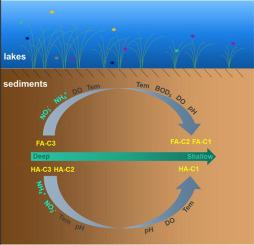Journal of Hydrology ( IF 5.9 ) Pub Date : 2021-10-23 , DOI: 10.1016/j.jhydrol.2021.127079
Xinyu Song 1 , Chunhao Zhang 1 , Xinya Su 1 , Longji Zhu 1 , Zimin Wei 1 , Yue Zhao 1

|
As an important part of lake ecosystems, sediments play a key role in the carbon cycle in lakes. Due to the complex sources of organic matter in sediments, the link between sequestration and transformation of humic substance is largely unknown. Therefore, it is essential to understand the characteristics of humic substance in lake sediments. In this study, the relationship between the characteristics of humic substance and environmental conditions was found in sediment samples from six typical lakes of northeast China. The structure of humic substance (HS), fulvic acid (FA) and humic acid (HA) tended to be simplified with decreasing lake depth. Pearson analysis indicated that characteristics of humic substances in deep lake sediments were dominantly determined by nutrient factors (e.g., NO3−-N, NO2−-N, NH4+-N) and physicochemical factors (e.g., pH, water temperature, dissolved oxygen), while the changes of HS in shallow lake sediments were dominantly determined by physicochemical factors (e.g., pH, water temperature, dissolved oxygen). Variation partitioning results also indicated that nutrient factors and physicochemical factors explained 64% and 24.2% of the variations of HS content in boreal deep lakes. In comparison, physicochemical factors explained most of the variation (35.6%) of HS composition, while nutrient factors only explained 3.4% of the variation in shallow lakes. Structural equation models further confirmed that complex components were transformed into simple components by nutrient and physicochemical factors with decreasing lake depth. This study suggests that changes in environmental conditions with lake depth may result in changes in the quality of HS in lake sediments.



































 京公网安备 11010802027423号
京公网安备 11010802027423号